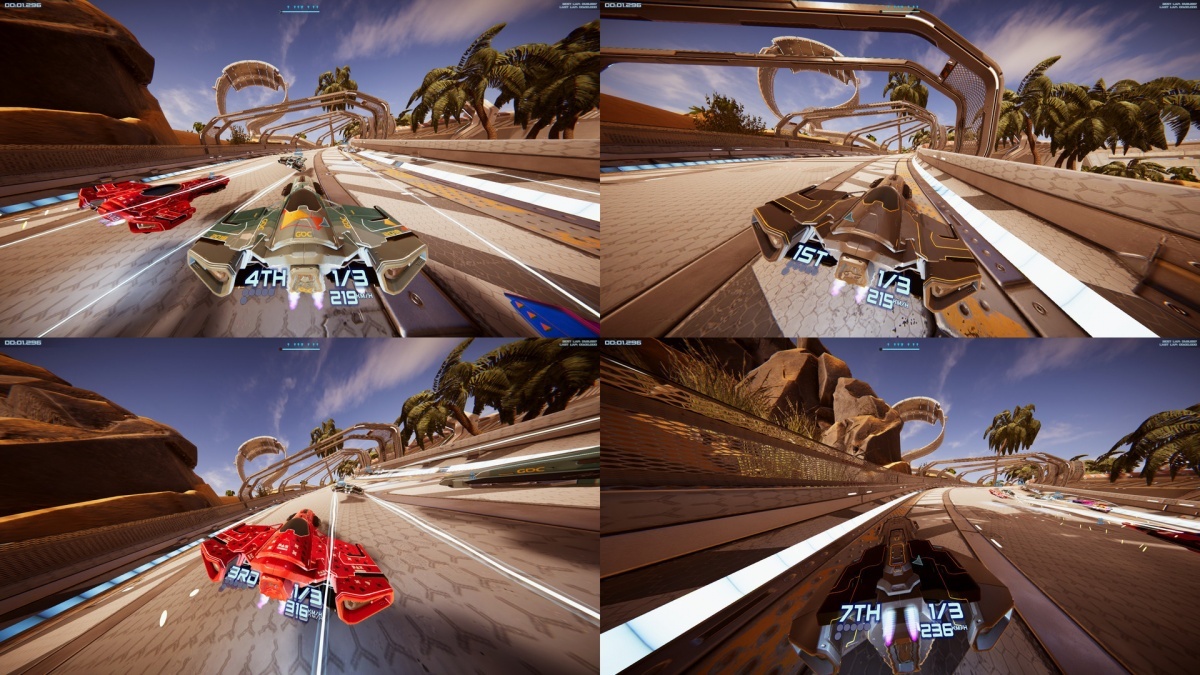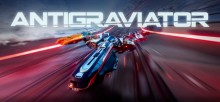Antigraviator (PC) Review
By Tomas Barry  04.06.2018
04.06.2018

In recent years, anti-gravity racers have been on the comeback trail. Although gamers have yet to receive new instalments from the stalwart series, F-Zero and WipEout, the latter did receive a re-mastered collection on PS4 in 2017, and in the meantime, other titles, such as Redout and FAST RMX have plugged the remaining void admirably. Now, with its debut title, Belgian indie developer Cybernetic Walrus, comprised of alumni from Howest University, aims to present a brand new challenger for the anti-gravity crown. Published by Iceberg Interactive and available on PC from 6th June, with PS4 and Xbox One versions due later in the year, Antigraviator is an eye-watering high-velocity experience, equipped with some interesting mechanical twists and tweaks to help distinguish itself. Developed with the Unity Engine, the game also featured at the 2017 Unite Austin 'Made With Unity' showcase, thanks to its gorgeous visuals. Is it a worthy contender, then?
There's something quite intuitively familiar about Antigraviator, which is both a good and a bad thing. It has already alluded to the fact that it is quite a specific sub-genre. Play F-Zero and you will pretty much 'get' how to approach WipEout or Redout, and vice-versa, despite the differences in handling and tone. Consequently, it is quite important for a new series to distinguish itself, however it can. In recent times, the most successful title in this regard is probably FAST RMX, due to its phase-switching system that really keeps players on their toes, since it influences momentum, boost, and track navigation so intricately. Innovation like this definitely helps to sustain the life of anti-gravity racers, since they do tend to feel quite closely connected, even if going from one series to another. After all, an eye-watering sense of speed, gorgeous graphics, and intense combat mechanics are all pretty much the essentials of the genre.
Thankfully, Antigraviator does take a different approach in some ways, introducing refreshing twists on the existing formula. Its most unique feature is its trap mechanic, which triggers track-specific hazards, like cascading rock falls, to ensnare and scupper rivals, which creates quite a lot of generalised mayhem, in the vein of Mario Kart. However, this functionality seems more directly derived from Split/Second. It definitely creates a different ebb and flow of the racing experience, but it is not without its flaws. Being on the lookout for a visual cue to trigger an environmental hazard is just not as satisfying as watching a homing missile stalk and smash through the rear-end of a competitor ahead. Firstly, you are just not seeing the destruction unfold, and secondly, constantly being on the lookout for an icon can be distracting when trying to nail a tricky corner. It's a shame that this can detract from the technical side of the racing, since there are some cool tweaks to speak of in that department.

Players can air-brake with the left trigger, which is a really useful and tactile way to modify your line very slightly at a blistering pace. It feels very satisfying to perform, and can often be the difference between nailing the apex and drifting wide into a wall or hazard. This sort of extra control is something that other anti-gravity racers tend to lack. In FAST RMX, for example, there are plenty of moments when crashing out feels totally unavoidable and unfair. By contrast, when crashing or ending up ensnared by a trap, it's usually due to a lapse in your concentration, rather than something totally and utterly unavoidable. This really helps the racing flow, and speaks of the fine balance struck between Antigraviator's insane velocities and the player's sense of control. That said, though, there will be a fair amount of wall scraping until upgrades improve matters.
It's also possible to do barrel rolls by flicking the right analogue, in order to avoid traps at the last second, as well as to knock opponents off their line or into the path of hazards. Doing so also feels very satisfying indeed, and keeps players on their toes when in close proximity to others. The boosting in Antigraviator also seems nicely integrated. There are boost pads, which send you surging away immediately. Making use of these can often be somewhat of a calculated gamble, since, interestingly, there's no maximum speed! This means gathering even more momentum before a tricky corner can sometimes be detrimental, which really adds to the tension. In addition, orange cells are spread across each track, which can be collected and used to boost at will. They are also used to activate traps, however, so players have to manage this dual-function, and decide what will serve them best in each given circumstance. Overall, the technical driving mechanics in Antigraviator feel really fluid and responsive, and work well in combination with the intertwined boosting and trap mechanics.

Unfortunately, Antigraviator lets itself down in other departments. It offers five different settings, comprising three courses each, in addition to reverse courses. These are all quite generic and unsurprising locales in the aesthetic sense, but that's fine, since that is true of most anti-gravity racers - and this one does look particularly fantastic, with absolutely amazing vista views. However, the track layouts themselves leave something to be desired. They are by no means terrible, but are also nowhere near as varied or memorable enough, either. This is something sci-fi racers seem to be missing a beat with. Sure, it's an arcade experience, but why can't there be a particularly unusual and unforgiving corner on a particular track? One that sort of defines that course.
Switching gears briefly to real racing and sim racing, most tracks stand out for one exciting and defining corner. The Wall of Champions at Montreal, the Corkscrew at Laguna Sec - these features provide the tracks with character just as much as their locale. There's no good reason why arcade-based track layouts can't have equivalent distinguishing features. When players boot into a particular course, their minds should instantly go to that one sector that they need to nail; the triple loop-the-loop at Cryon Terminal, or whatever. Instead, the layouts in Antigraviator all seem a bit arbitrary, due to the lack of distinct and defining track features. All tracks have a bit of everything, rather than a proper emphasis. Players should really love some courses, and really detest others. Instead, though, they will likely feel pretty neutral about every single one, across the board - even though they all twist and turn and throw drivers every which way. It should be noted that this could be levelled at many other anti-gravity racers, but since the handling mechanics are so poised in this experience, better and more thoughtful track layouts would have gone much further here.

In terms of modes, everything generally expected is present. The championship mode consists of four-race tournaments, which earn you credits and unlock the next league, providing the player wins it overall. Perhaps the team could have integrated other game-modes into the championship setup, but it works well in its quick-burst, quick-progression form. Of course, the real reward is the credits earned, as they can be used in the Hangar to upgrade your vehicle. These are divided into just three categories; handling, storage, and acceleration. While, admittedly, that's quite a streamlined approach to upgrading, it is one that works well. League progression happens quite quickly, unless you are going back to farm credits from easier tournaments. Hence, at least initially, deciding whether to improve your craft's cell storage capacity over, for example, improving its handling for those tight corners, does somewhat inform the player's race strategy. The Hangar also allows players to customise their vehicle, and apply decals, of which there are plenty of options.
In deathrace mode, the aim is to survive as long as possible, withstanding opponents, as well as dealing with a plentiful amount of traps. This is a nice variant, but perhaps it could have benefited from a few more mode-specific additions. It just doesn't stand out from the standard racing experience all that much. Whereas, with a bit more care and attention, it could have stood out in the way that road-rage mode stands out from a normal Burnout race. Lastly, there's countdown mode, which is a race-against-the-checkpoint mode that can be a fun variant, except that it doesn't really hold the attention for that long, either. As expected, the main draw, outside of the championship mode, is its multiplayer. Unfortunately, Cubed3 missed the opportunity to test the online multiplayer during pre-release, but it is certainly good to know that there will be online leader-boards and rankings. In addition, Antigraviator features four-player split-screen multiplayer, which is fantastic fun, although delegating just one quarter of the screen to each player makes it difficult to spot traps and be precise! Overall, though, this aspect of the game will serve it extremely well in terms of longevity.

Cubed3 Rating
Very Good - Bronze Award

Antigraviator gets a lot of things right. Its responsive handling and evasive manoeuvres help the racing feel particularly fluid. The boosting system and the lack of a top-speed really enhances the exhilaration factor, too. Managing cells for use between boosting and traps also adds a nice strategic layer. However, the trap mechanic and how it's integrated is disappointing. They are not as dynamic or satisfying to use as in Split/Second, it's annoying that only one can be active at a time, and it's distracting looking out for the icon to trigger them. While they create a unique ebb and flow, the mechanic is not as well implemented as it could have been. In addition, the tracks and locations aren't particularly varied, and seem quite generic, which is a shame. That said, fans of the genre will feel obliged to check this one out, and will appreciate its stunning visuals and the enjoyable handling model.
Comments
Comments are currently disabled

 Sign In
Sign In Game Details
Game Details
 Out now
Out now  Out now
Out now  Out now
Out now  Out now
Out now  Subscribe to this topic
Subscribe to this topic Features
Features





 Top
Top

